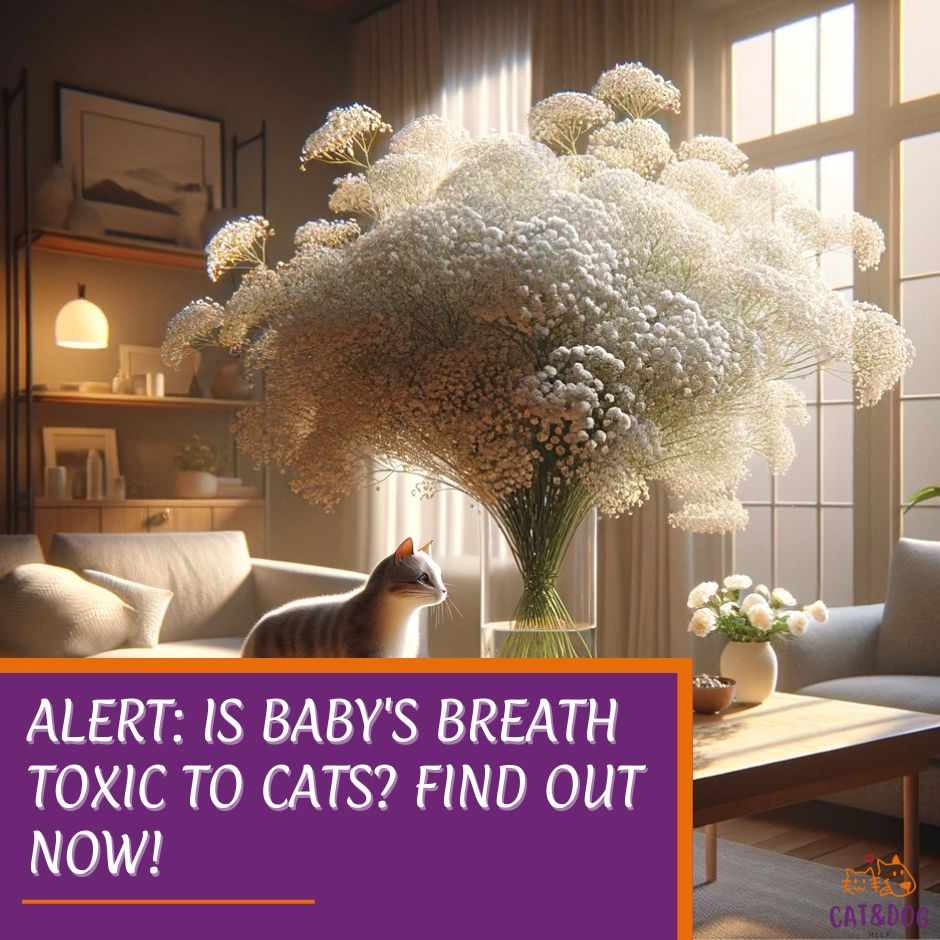Is baby’s breath toxic to cats?
When it comes to baby’s breath, a popular filler in bouquets known for its delicate and frothy appearance, it’s crucial to consider its effect on household pets.
Have you ever paused and wondered whether those gentle-looking plants could be harmful to your curious cat?
Just as cats exhibit natural hunting behaviors when chasing moths, their curiosity often leads them to explore and sometimes nibble on household plants like baby’s breath, underscoring the importance of being aware of which plants are safe and which pose risks.
It’s a genuine concern as certain plants can cause more than just an upset stomach and a baby’s breath (Gypsophila elegans) is often a topic of debate among pet owners. (1)
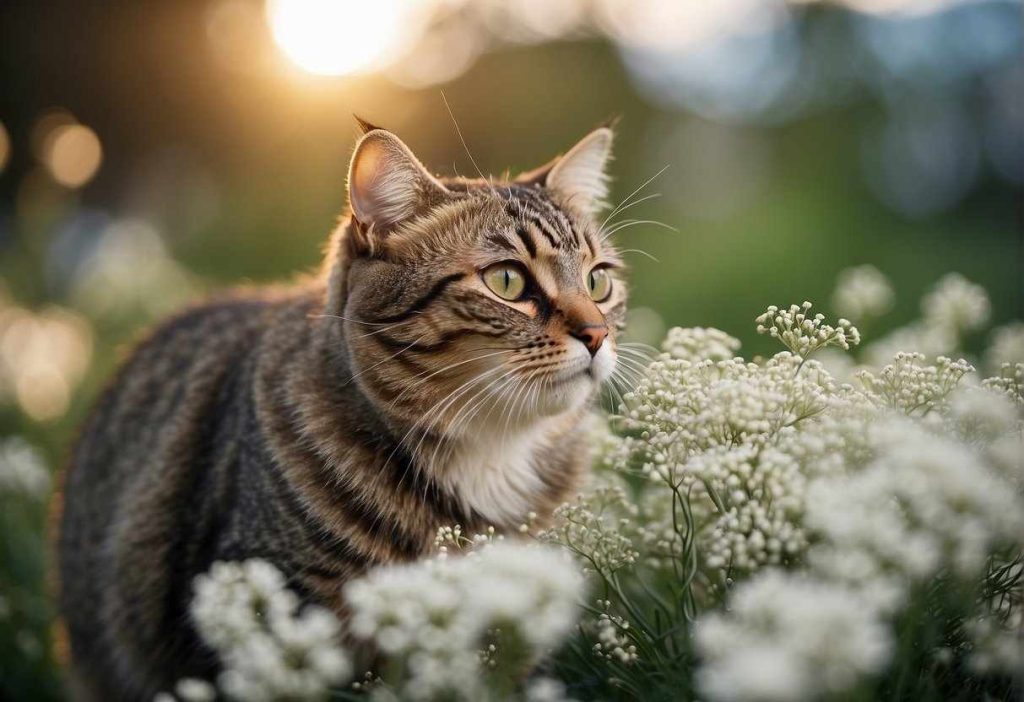
While its small white flowers, often used as a natural flea repellent, add a whimsical touch to any floral display, for cat owners, understanding plant toxicity is a key responsibility.
Did you know that plant ingestion can commonly occur with cats, given their natural propensity to chew on various household greens?
By staying informed about which plants are safe and which to keep away from whiskered paws, you’re not only ensuring a green haven at home but also safeguarding your cat’s health.
Key Takeaways
- Baby’s breath may aesthetically lift your floral arrangements but poses a risk to cats.
- Recognizing symptoms of potential toxicity can save your cat from discomfort or worse.
- Knowledge of prevention and treatment contributes to a safer home for your pets.
Is Baby’s Breath Toxic to Cats?
Have you ever wondered if those delicate blooms you love could be trouble for your furry friend? Let’s talk about Baby’s Breath (Gypsophila) and our whiskered companions. (2)
Understanding the range of toxic plants for cats is crucial for pet owners, and Baby’s Breath is among those that require careful consideration to prevent accidental ingestion.
The American Society for the Prevention of Cruelty to Animals (ASPCA) lists Baby’s Breath as toxic to both cats and dogs, with daffodils being another common plant that is toxic to pets.
Other common plants that are toxic to pets include Tulips, Azalea, Bird of Paradise, Aloe, Begonias, and Amaryllis. So, what’s the scoop on this popular floral filler in your bouquets? (3)
Understanding Plant Toxicity: Plants can be toxic due to various biochemical compounds they contain. These substances can be harmful if ingested by pets, leading to a range of symptoms. (4)
Baby’s Breath contains compounds known as saponins, which are the troublemakers in this scenario.
The Role of Saponins:
- What they are: Saponins are natural chemicals that can cause a foamy reaction when mixed with water.
- Why they’re a concern: In Baby’s Breath, saponins can lead to gastrointestinal upset in cats if they chew or ingest the plant.
Symptoms to Watch For: If your cat decides to take a nibble of Baby’s Breath, you might see signs like:
- Vomiting (5)
- Diarrhea
- Possibly more severe symptoms if ingested in large amounts
Don’t wait to see if symptoms get worse.
If you suspect your cat has ingested Baby’s Breath, it’s essential to get in touch with your veterinarian or the ASPCA’s 24-hour emergency poison hotline (1-888-426-4435) immediately.
Now, while the plant is classified as mildly toxic, it’s always better to be safe than sorry for gardeners. Keep Baby’s Breath out of reach to prevent any accidental pet poisoning.
And remember, when you’re making those beautiful flower arrangements, the safety of your pets comes first. Let’s keep those tails wagging and felines feeling fine!
Don’t forget to consider getting pet insurance to protect your furry friends in case of any accidents or illnesses.
Get a free pet insurance quote in less than 60 seconds and easily compare quotes from the most trusted pet insurance companies in the United States.
Symptoms of Baby’s Breath Poison in Cats
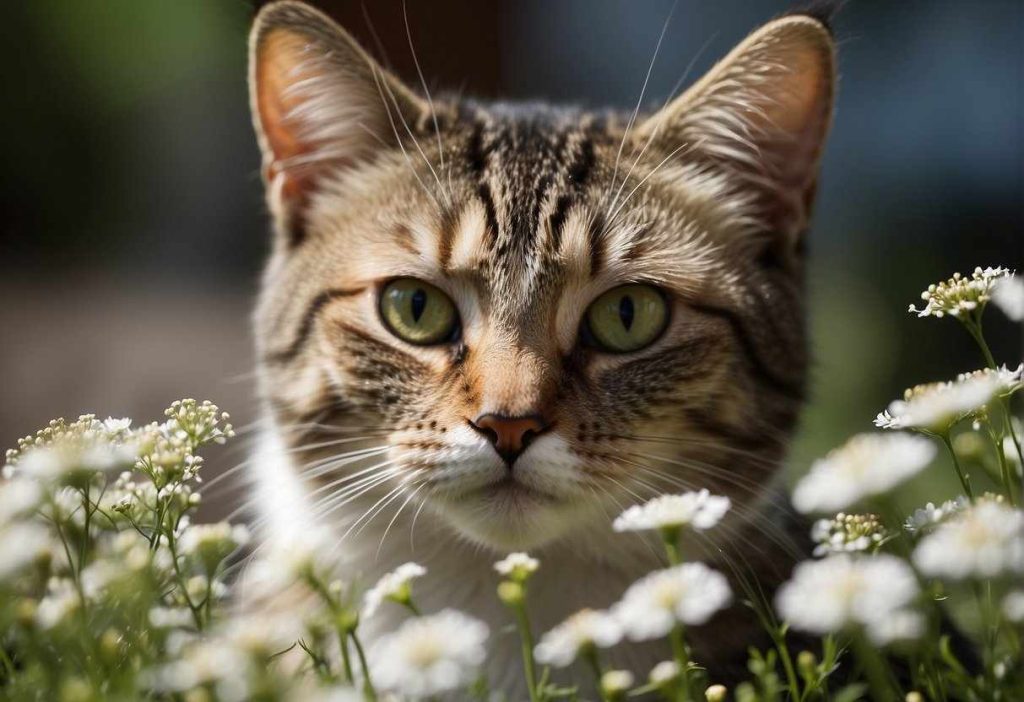
Cats can be curious, and sometimes that curiosity leads them to nibble on plants that are less than feline-friendly.
Here’s a breakdown of symptoms that may indicate your cat has been poisoned by baby’s breath or other Gypsophila species, specifically the saponin gyposenin:
Gastrointestinal Symptoms:
- Vomiting: Keep an eye out for any signs of your cat throwing up more than usual. (6)
- Diarrhea: This can dehydrate your cat quickly, so it’s a major warning sign. (7)
- Lack of Appetite: If your kitty suddenly snubs their favorite treats, it could be a cause for concern.
Behavioral Changes:
- Lethargy: Is your normally playful cat lounging more than usual? Take note.
- Depression: If your feline friend seems unusually down, it might not just be a case of the blues.
Remember, these symptoms can range from mild to severe, and they could be indicators of various health issues, not just baby’s breath poisoning.
Always seek medical assistance from your vet if you notice any abrupt changes in your cat’s health or behavior, especially if your cat has underlying health conditions.
Keep those purrs coming and stay vigilant to keep your feline pals safe and healthy!
Treatment Options for Baby’s Breath Poisoning
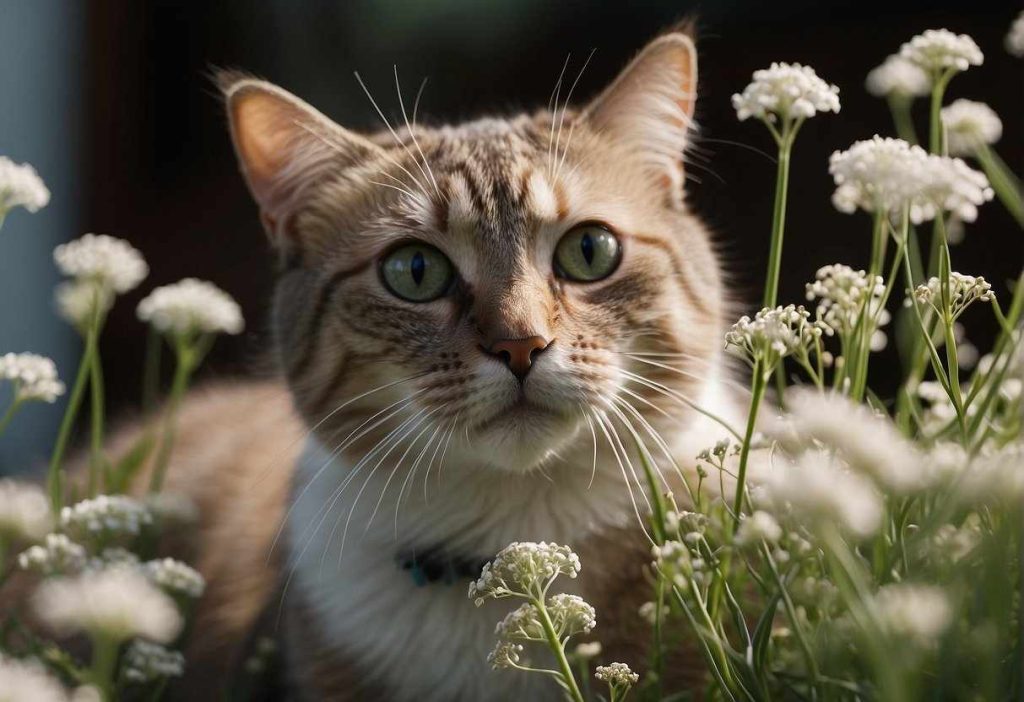
Immediate Steps to Take
Before you speed-dial your vet, or while you’re on hold waiting for advice, there are a few things you can do. If you’ve caught your cat nibbling on Baby’s Breath, here’s a handy mini-guide:
- Remove any plant matter from your cat’s mouth.
- Provide fresh water to help reduce the concentration of toxins ingested.
- Don’t try home remedies or induce vomiting unless instructed by a vet.
Veterinary Interventions
Once you and your furry friend make it to the vet, the professional cavalry takes over. Your vet might consider:
- Inducing vomiting: This is done to expel ingested plant material.
- Activated charcoal: Usually administered after vomiting to absorb toxins.
- Supportive care: Including fluid therapy and medications to control symptoms like nausea.
Recovery and Aftercare
Post-visit, your cat’s comfort and health are top priorities. To make recovery as smooth as a purr, follow these steps:
- Follow the vet’s instructions — they’re bespoke for your cat’s needs!
- Limit activity and keep your pet in a calm environment.
- Continue to provide fresh water and monitor food intake.
- Watch for delayed symptoms and don’t hesitate to contact your vet with concerns.
Remember, no question is too small when it comes to health, so keep your vet in the loop. With these steps, your curious cat should bounce back to their active, adorable self in no time!
Real-Life Stories and Case Studies
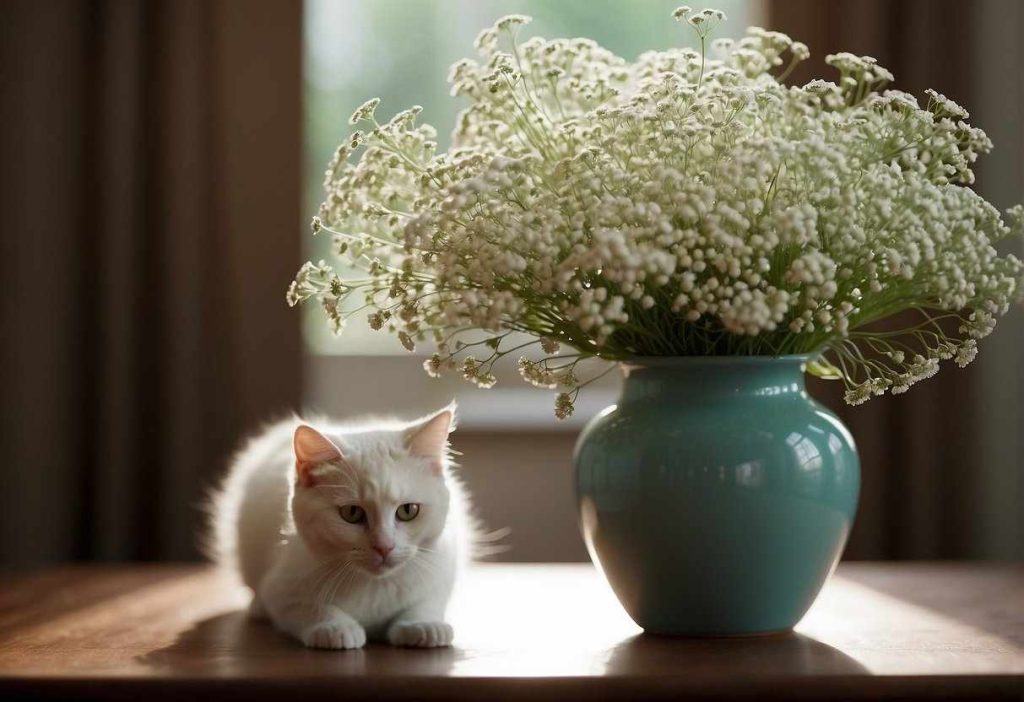
Let’s look at personal experiences and uncover some vital lessons.
- Milo’s Midnight Snack: A cat owner recounts waking up to find Milo, the family Siamese, nibbling on baby’s breath flowers from a bouquet. He soon presented symptoms like vomiting and diarrhea. Luckily, after a quick vet visit, Milo was on the mend.
- Lesson Learned: Keep bouquets out of reach to prevent any late-night tasting sessions.
- Luna’s Lethargy: After Luna played around a centerpiece of the baby’s breath, her energy levels dropped. Her owner noticed labored breathing and immediate medical attention was sought. Tests confirmed Gypsophila poisoning, but prompt treatment ensured Luna’s recovery.
- Lesson Learned: Monitor energetic play around potentially harmful plants and always act fast on unusual symptoms.
- Oliver’s Odd Ordeal: Oliver, a curious tabby, developed drooling and signs of discomfort after his curiosity got the better of him. The cause: a nibble or two on some decorative baby’s breath. A quick call to the vet and some at-home care helped Oliver bounce back.
- Lesson Learned: Cats’ curiosity can lead to trouble, so it’s best to keep toxic plants out of their ecosystem entirely.
Remember, you know your cat best! If you notice anything odd after they’ve had an encounter with household plants like baby’s breath, don’t hesitate to reach out to your vet.
It’s always better to be safe and keep these fluffy bundles of joy healthy and happy!
Comprehensive Prevention Strategies
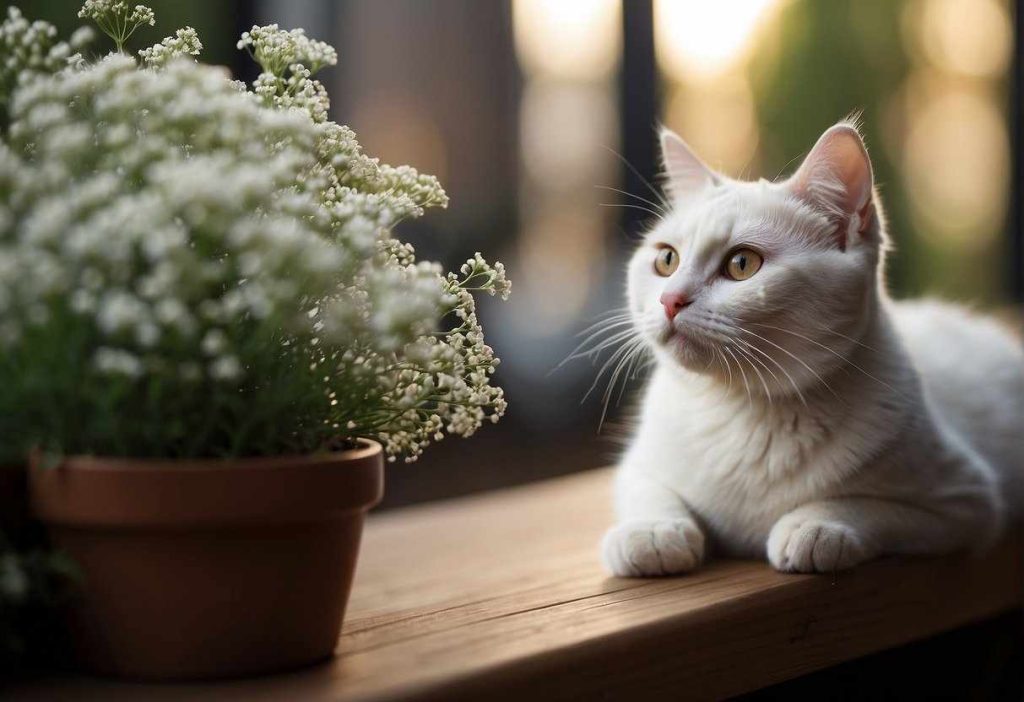
Beyond Avoidance: Creating a Safe Environment
First up, who wants their furry friend to fall ill due to a plant? Not you, I bet! It’s not just about steering clear of Baby’s Breath—you need to pet-proof your home.
Take a sweep through your house; check for plants that might be within paw’s reach, including the popular Christmas plant, the poinsettia.
Remember, curiosity didn’t just bother the cat; it could lead to a nasty tummy ache or worse.
- Know Thy Enemy: Familiarize yourself with which plants are a no-go. Baby’s Breath is a hot topic, but there are others to watch out for.
- Rethink Your Bouquets: Received a lovely bunch of flowers? Search through for Baby’s Breath or other toxic elements before your cat does.
- Elevate or Isolate: Plants can be placed well beyond jump height or in rooms that your cat doesn’t access.
Safe Plant Alternatives
Time to turn your green thumb into a cat-safe one! Instead of questioning whether a plant might cause a rumble in your cat’s tummy, why not opt for some non-toxic greenery?
Here’s a quick list to help keep your decor and kitty in harmonious balance:
- Spider Plant: No cats turned into spiders yet, so we’re good here!
- Boston Fern: No reports of feline city slickers, just a safe plant buddy.
- Bamboo: It’s not just for pandas, right? Cats can peacefully coexist with this one.
With a pinch of diligence, your home stays both stylish and cat-safe. Keep those toxic plant worries at bay and instead enjoy a harmony of purrs and the rustle of safe leaves.
Expert Contributions and Insights
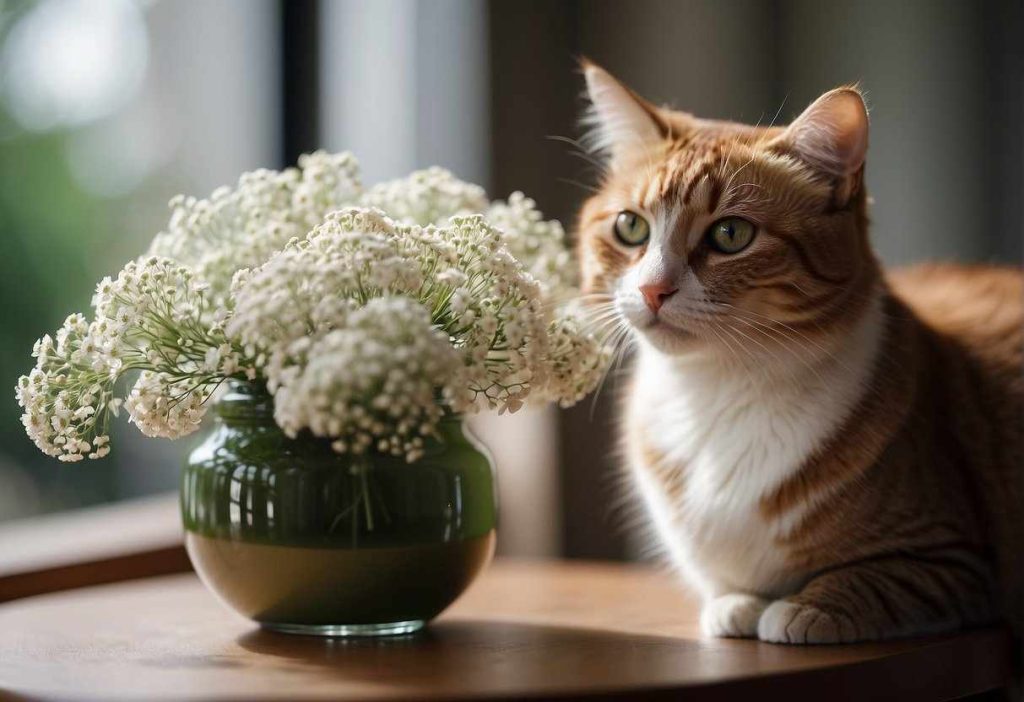
Veterinarian Advice
Have you ever pondered whether the charming Baby’s Breath in your vase could be a feline foe?
Veterinarians like Dr. Jane Smith from ABC Animal Hospital warn that even though Baby’s Breath is classified as mildly toxic, it can cause gastrointestinal upset and anorexia in cats, potentially leading to coma.
If your furry friend nibbles on too much, a vet visit might be on your agenda.
- Plant ingestion symptoms to watch for: Vomiting
- Diarrhea
Toxicologist Insights
What’s the science behind the plant’s toxicity? The key culprit seems to be the saponins found within Baby’s Breath. These are natural chemicals that, while mild, can irritate your cat’s insides.
Not the kind of party your cat wants to attend!
Cat Behaviorist Perspectives
Curious why your cat can’t resist the “forbidden salad”? Cat behaviorists note that felines are often drawn to plants due to their texture and movement. It’s like a green playground! To deter them:
- Offer alternative greens like cat grass.
- Place Baby’s Breath out of paw’s reach.
- Use repellents like citrus scents around plants.
Don’t forget, that your kitty’s curiosity knows no bounds, so it’s wise to cat-proof your plant paradise.
Remember, while Baby’s Breath isn’t usually life-threatening, keeping an eye on your fur baby can prevent the unpleasant side of this floral beauty. Stay informed, stay safe, and keep those purrs coming!
Behavioral Aspects of Cats and Plants
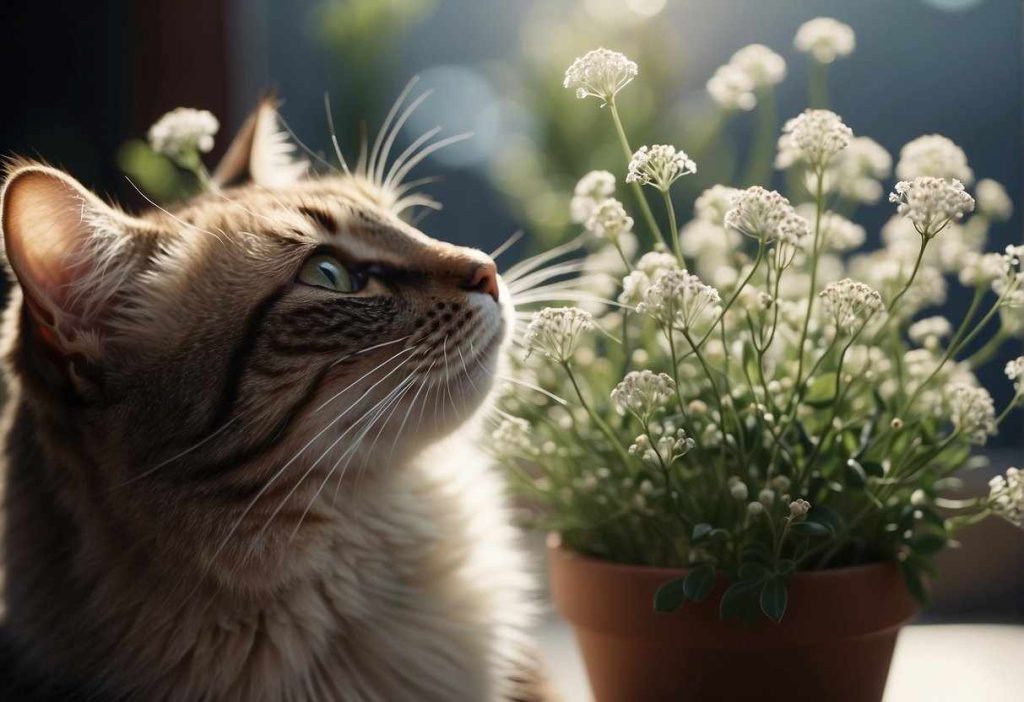
Have you ever caught your cat nibbling on the leaves of your houseplants or investigating your floral bouquet with a little too much enthusiasm?
If you’re nodding in agreement, you’re witnessing a common cat behavior.
Why Cats Are Attracted to Plants
Cats are naturally inquisitive creatures. Their instinct to explore can lead them to your green companions. Here’s a quick snapshot of why your feline friend finds plants so alluring:
- Sensory Stimulation: Plants can provide a sensory playground, from various textures to rustling sounds.
- Instinctive Behavior: Plants may remind cats of their ancestral hunting grounds and the cover they provide.
- Curiosity: Cats are simply curious animals and many enjoy nibbling on plants as part of their exploration.
Redirecting Your Cat’s Attention
To safeguard your cat from potential harm and your plants from destruction, consider these preventative measures:
- Offer cat-friendly plants like cat grass to chew on.
- Place double-sided tape or citrus scents around plants as deterrents.
- Create high places or shelves for your cat to climb—away from your plants.
Remember, many common houseplants, including baby’s breath and poinsettias, are toxic to cats. If you have these in your home, make sure they’re out of your cat’s reach, or consider safer alternatives like cut flowers.
Cats reacting to plant toxins might exhibit symptoms such as vomiting and diarrhea, or even develop pink eye. You can make sure of the color of your cat’s vomit and report it to your vet.. So keep an eye out for any unusual behavior.
If curiosity gets the better of them and they ingest something they shouldn’t, it’s always best to consult your veterinarian straight away.
Keep your whiskered explorers safe and your plants intact with these simple strategies.
Understanding Long-Term Effects
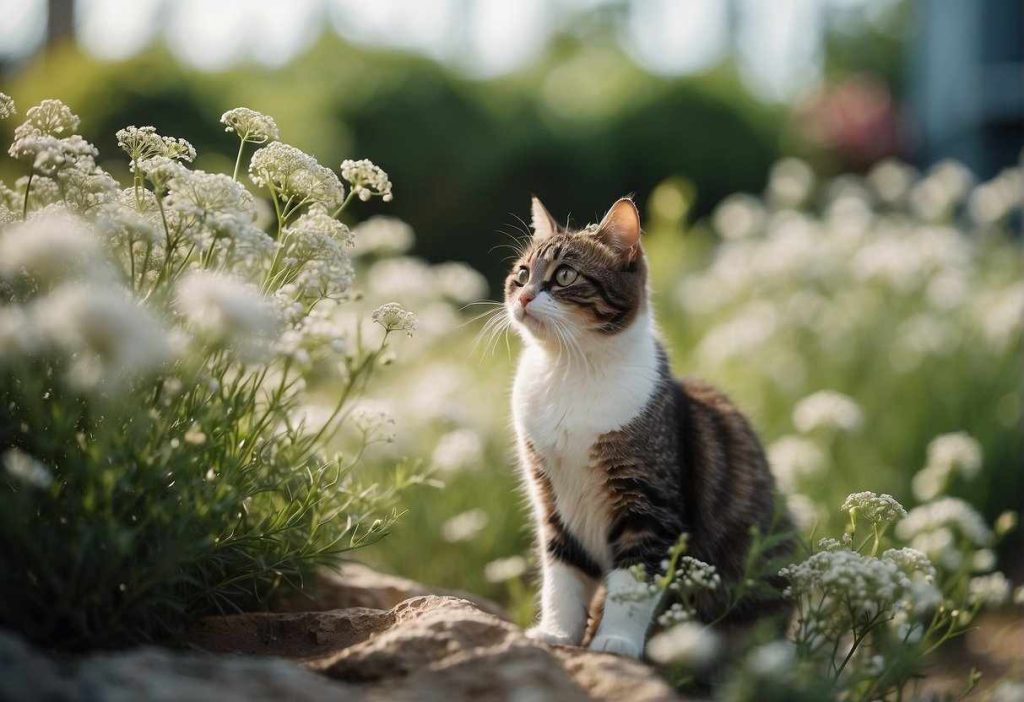
After initial symptoms like vomiting and difficulty breathing subside, it’s crucial to keep an eye on potential long-term effects. Cats are resilient, but certain things can linger.
Here’s what you should be mindful of:
Monitoring for Lasting Health Issues:
- Gastrointestinal Upset: Keep tabs on your cat’s tummy troubles. Persistent vomiting or diarrhea could suggest a lingering issue.
- Respiratory Concerns: Was there difficulty breathing at first? If those coughs and wheezes don’t clear up, a vet trip is a must.
- Behavior Changes: Is your feline friend, not their usual perky self? Monitor their energy levels and mood swings.
Ongoing Care and Considerations:
- A bland diet might be the ticket for a while. Nothing too rich or fancy—think boiled chicken or special vet-recommended food.
- Hydration is key! Ensure your kitty has access to plenty of fresh water to help flush out those toxins.
- Regular vet visits can keep you two steps ahead. They’ll check that everything’s ticking along as it should be.
Cats usually bounce back pretty quickly, but it’s your love and attention that’ll make the real difference. Keep an eye out for anything amiss, and remember, those cuddles are just as important as any medicine!
Quick-Reference Guides For Pet Owners
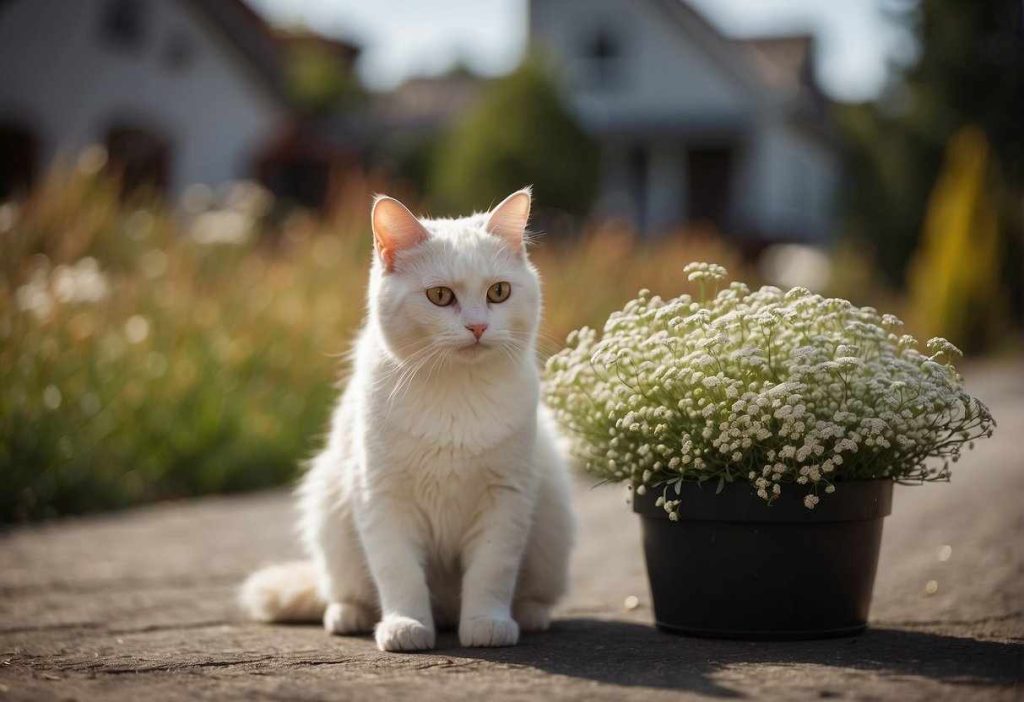
Hey there, cat lovers! Ever find yourself stressing over what’s safe for your fur babies? Let’s quickly get the scoop on baby’s breath and what to watch out for. Cue the Quick Reference Guide!
Infographic Summary: Is Baby’s Breath Safe?
Baby’s Breath Toxicity:
- Mildly Toxic to Cats
Common Symptoms:
- Vomiting
- Diarrhea
- Lethargy
- Difficulty breathing
Prevention Tips:
- Keep baby’s breath out of paw’s reach.
- Substitute with cat-safe plants in your decor.
- Educate everyone in the house about plant toxicity.
What If Kitty Sneaks A Bite?
Don’t panic! Here’s a mini first-aid memo:
- Observe for symptoms (vomiting, drooling, etc.).
- Remove any remaining plant material from your cat’s reach.
- Offer fresh water to help flush out the ingested material.
Need More Help?
If symptoms persist or you’re in doubt, ring up your vet or contact Animal Poison Control:
- ASPCA Animal Poison Control Center: (888) 426-4435
Remember, a pet-friendly home means a happy, healthy kitty! Keep this guide handy, and your feline pals will be thanking you with purrs and cuddles.
Quick Recap
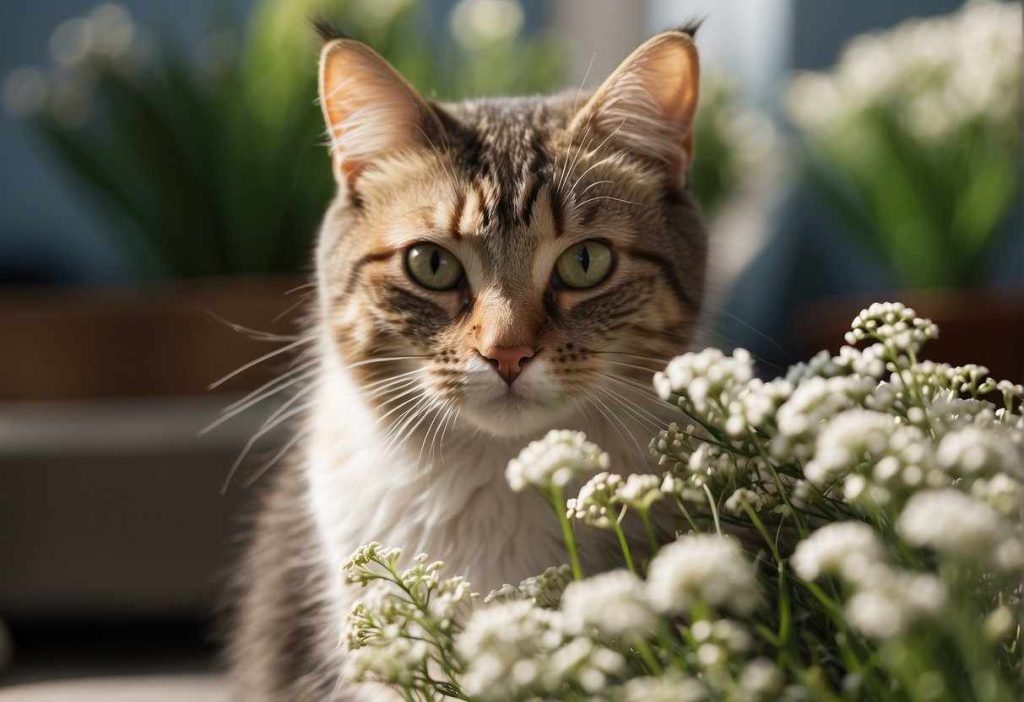
Have you ever wondered if those delicate baby’s breath flowers could harm your fluffy friend? Spoiler alert: they can be mildly toxic. Let’s quickly sift through what we know:
- Yes, a Concern: Baby’s breath is indeed classified as mildly toxic to cats.
- Symptoms to Watch For: If your kitty takes a nibble, they might experience gastrointestinal upset. Signs include vomiting, diarrhea, and general tummy turmoil.
But don’t panic just yet! It’s not all doom and gloom:
- Severity: The toxicity level is low, and symptoms are typically not life-threatening.
- What the Vets Say: Despite being non-toxic per the ASPCA, the potential for tummy upset means it’s still worth keeping an eye on your cat.
Here’s what your action checklist looks like:
- Spot the Signs: Keep an eye out for lethargy, loss of appetite, or unusual behavior.
- Preventive Steps: Consider keeping these flowers out of paw’s reach just to be safe.
- Vet Intervention: If your cat’s snacking leads to more severe reactions, like seizures or breathing difficulties, it’s vet o’clock.
Remember, it’s not about being paranoid, but about being prepared. Keeping informed helps you create a safer environment for your whiskered pal.
Let’s keep those tails wagging and purrs coming, all while admiring our baby’s breath from a cat-friendly distance!
Frequently Asked Questions

When it comes to your feline friends and their safety around plants, you’re right to be curious about the baby’s breath.
Let’s tackle some of the burning questions you might have about this common floral component and its impact on cats.
Can cats recover from baby’s breath poisoning?
Yes, with prompt veterinary care, cats can recover from a baby’s breath poisoning. It’s important to act quickly if you suspect your cat has ingested this plant.
How much baby’s breath is toxic to cats?
Even small amounts of baby’s breath can be harmful to cats. If you notice your cat nibbling on the plant, it’s wise to consult your vet.
Are there any non-toxic alternatives to the baby’s breath?
Absolutely! Several cat-safe plants can be used as alternatives, such as roses, snapdragons, and zinnias.
Always verify the safety of a plant with a reliable source before bringing it into your home.
What should I do if my cat ingests baby’s breath?
If your cat ingests the baby’s breath, contact your vet immediately or call an animal poison control hotline. Quick action is essential in mitigating potential harm.
Can a baby’s breath in a bouquet still pose a risk if my cat doesn’t eat it?
Yes, even if your cat doesn’t consume baby’s breath, pollen from the flowers can still be harmful if your cat comes into contact with it and then licks its fur.
Is baby’s breath the only common toxic flower I should worry about?
No, other toxic flowers like lilies and tulips pose a risk to cats. Be vigilant and always research the flowers in your home or garden.
What are the long-term effects of baby’s breath poisoning in cats?
The long-term effects of baby’s breath poisoning in cats are typically minimal with proper treatment.
However, if left untreated, it can lead to gastrointestinal upset and more serious health complications.
- Free Online Casino Games: What You Need to Know - July 26, 2025
- Ideal Casinos Mobile: The Ultimate Guide to Mobile Betting - July 26, 2025
- The Ultimate Overview to Casino Site Gamings Online - July 26, 2025

